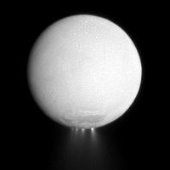ESA Science & Technology - News Archive
News archive
News archive
Herschel survey confirms that only the most powerful black holes in the early Universe were able to quench the formation of stars in their host galaxies.
Published: 10 May 2012
New Herschel images reveal the debris disc around the star Fomalhaut in its full glory. By probing the glow of dust in the disc, these data suggest that it consists of 'fluffy' aggregates of dust grains produced by cometary collisions.
Published: 11 April 2012
Sub-millimetre observations of 2M1207, a brown dwarf with its own circumstellar disc and a planetary companion five times more massive than Jupiter, reopen the debate on how giant planets form around stellar and sub-stellar objects.
Published: 13 March 2012
The detection of cold water vapour in a protoplanetary disc hints at a hidden reservoir of water ice amounting to several thousand terrestrial oceans.
Published: 20 October 2011
Herschel has found the first evidence of Earth-like water in a comet; this promises to reopen the debate on the role of comets in delivering water to our planet.
Published: 5 October 2011
New insights into the processes by which stars age have been revealed by ESA's Herschel Space Observatory, which is providing unprecedented images of the complex, outer structure of a nearby circumstellar envelope.
Published: 20 September 2011
Herschel's deep galaxy survey reveals that, contrary to previous belief, most stars in cosmic history did not form through violent mergers but via steady and gentle processes.
Published: 13 September 2011
Herschel has found the first robust evidence of molecular oxygen in the Orion Nebula, shedding new light on where most interstellar oxygen might be 'hidden'.
Published: 1 August 2011
Herschel has detected water in a huge torus around Saturn, which is supplied by its moon Enceladus and, in part, precipitates into the atmosphere of Saturn.
Published: 26 July 2011
Astronomers have detected a surprisingly large amount of dust in the remnant of supernova SN1987A, located in the nearby Large Magellanic Cloud, shedding new light on the mechanisms that produce dust in galaxies.
Published: 7 July 2011
The second (and final) in-flight Announcement of Opportunity (AO) for Open Time (OT2) observations with the Herschel Space Observatory has been issued. The OT2 call solicits proposals from the worldwide astronomical community. The deadline for proposal submissions is: 15 September 2011 at 12:00 UT.
Published: 10 June 2011
Herschel's detection of molecular gas outflows in merging galaxies proves that feedback processes can exhaust the galactic gas supply for creating stars and feeding the black hole.
Published: 9 May 2011
An intricate network of filamentary structure, exposed in extraordinary detail by Herschel, has provided new evidence for how stars form from the diffuse interstellar medium.
Published: 13 April 2011
How much dark matter is needed to trigger a starburst in the cosmic cribs where galaxies are born? A new study, based on data from ESA's Herschel Space Observatory, yields an answer.
Published: 16 February 2011
Two ESA observatories have combined forces to show the Andromeda Galaxy (M31) in a new light. Herschel sees rings of star formation in the most detailed image of M31 ever taken at far-infrared wavelengths, and XMM-Newton shows X-rays from dying stars.
Published: 5 January 2011
Astronomers using early data from one of the largest projects to be undertaken with
Herschel have demonstrated that virtually all bright sub-millimetre galaxies in the distant Universe are subject to gravitational lensing.
Published: 4 November 2010
ESA's Herschel Space Observatory has detected water vapour in a location previously thought to be impossible - in the atmosphere of an ageing, red giant carbon star.
Published: 1 September 2010
152 new papers, describing the first scientific results obtained with Herschel are appearing, this week, in a special issue of the journal Astronomy & Astrophysics.
Published: 16 July 2010
The first in-flight Announcement of Opportunity (AO) for Open Time (OT1) observations with the Herschel Space Observatory has been issued. The OT1 call solicits proposals from the worldwide astronomical community and offers 6592 hours of Herschel observing time. The deadline for proposal submissions is: 22 July 2010 at 12:00 UT.
Published: 21 May 2010
Published: 6 May 2010
—
20 Items per Page


















